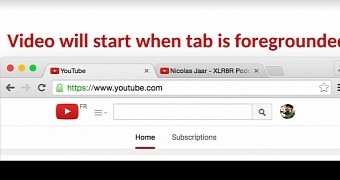The latest dev version of Google Chrome, along with the latest Chromium release, now includes an innovative new feature which will prevent noisy tabs from starting their automatic playback if the user has not selected them yet.
While both Chrome and Firefox have the ability to show a sound indicator in the tab strip and let users click on it to mute tabs, this ain't really useful when you start up the browser.
If you have 20 tabs with audio or video already opened, you'll have to find each one and click on its audio indicator to mute it.
Now this process has been simplified in Chrome, where all tabs will be silent by default until you click on them.
No more "Where's the sound coming from?" moments
"Videos which autoplay in the background will now have their load deferred until the tab is visible for the first time -- this avoids autoplay during session restore and premature playback," said a Chromium developer.
"Once a tab [...] has ever played media before, it's allowed to continue to autoplay/autoload indefinitely; this is to support playlist type applications," meaning you can still leave a YouTube video playing in the background, but you need to click on the tab first.
Additionally, François Beaufort, one of Google Chrome's engineers, also said "Resources will still be preloaded if indicated but Chrome will delay the start of playback until you actually visit the tab."
The same François Beaufort also announced a new Chrome feature, similar to what Firefox has introduced a few days back, one that simplifies the fullscreen notifications for HTML5 videos.
Starting September 1, Chrome will start pausing Flash ads by default
In other news, after previously announcing it in June that they'd start pausing Flash ads by default to save battery life, Google is now giving advertisers a deadline.
Starting September 1, the change will hit the stable Chrome release channel, so the AdWords team is urging publishers to convert their ads to HTML5.
To help advertisers get started, Google provides them with a Flash to HTML5 converter.
If you want to install the Chrome dev release, you can get it from Softpedia for Mac, Linux, and Windows.

 14 DAY TRIAL //
14 DAY TRIAL //